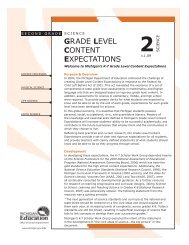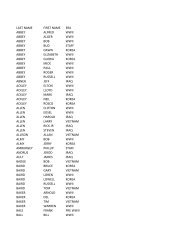Grade Level Content Expectations - State of Michigan
Grade Level Content Expectations - State of Michigan
Grade Level Content Expectations - State of Michigan
You also want an ePaper? Increase the reach of your titles
YUMPU automatically turns print PDFs into web optimized ePapers that Google loves.
Understand fractions<br />
N.ME.04.20 Understand fractions as parts <strong>of</strong> a set <strong>of</strong> objects.<br />
N.MR.04.21 Explain why equivalent fractions are equal, using models such as fraction strips<br />
or the number line for fractions with denominators <strong>of</strong> 12 or less, or equal to 100.<br />
N.MR.04.22 Locate fractions with denominators <strong>of</strong> 12 or less on the number line; include mixed<br />
numbers.*<br />
N.MR.04.23 Understand the relationships among halves, fourths, and eighths and among<br />
thirds, sixths, and twelfths.<br />
N.ME.04.24 Know that fractions <strong>of</strong> the form m n where m is greater than n, are greater than 1 and<br />
are called improper fractions; locate improper fractions on the number line.*<br />
N.MR.04.25 Write improper fractions as mixed numbers, and understand that a mixed number<br />
represents the number <strong>of</strong> “wholes” and the part <strong>of</strong> a whole remaining, e.g., = 1 + = 1 .<br />
N.MR.04.26 Compare and order up to three fractions with denominators 2, 4, and 8, and 3, 6,<br />
and 12, including improper fractions and mixed numbers.<br />
Add and subtract fractions<br />
N.MR.04.27 Add and subtract fractions less than 1 with denominators through 12 and/or 100,<br />
in cases where the denominators are equal or when one denominator is a multiple <strong>of</strong> the other,<br />
e.g., 1 12 + 5 12 = 6 12 ; 1 6 + 5 12 = 7<br />
12 ; 3<br />
10 – 23<br />
100 = 7<br />
100 . *<br />
N.MR.04.28 Solve contextual problems involving sums and differences for fractions where one<br />
denominator is a multiple <strong>of</strong> the other (denominators 2 through 12, and 100).*<br />
N.MR.04.29 Find the value <strong>of</strong> an unknown in equations such as + x = or - y = .*<br />
Multiply fractions by whole numbers<br />
N.MR.04.30 Multiply fractions by whole numbers, using repeated addition and area or array<br />
models.<br />
Add and subtract decimal fractions<br />
N.MR.04.31 For problems that use addition and subtraction <strong>of</strong> decimals through hundredths,<br />
represent with mathematical statements and solve.*<br />
N.FL.04.32 Add and subtract decimals through hundredths.*<br />
Multiply and divide decimal fractions<br />
N.FL.04.33 Multiply and divide decimals up to two decimal places by a one-digit whole number<br />
where the result is a terminating decimal, e.g., 0.42 ÷ 3 = 0.14, but not 5 ÷ 3 = 1.6.<br />
Estimate<br />
N.FL.04.34 Estimate the answers to calculations involving addition, subtraction, or multiplication.<br />
N.FL.04.35 Know when approximation is appropriate and use it to check the reasonableness<br />
<strong>of</strong> answers; be familiar with common place-value errors in calculations.<br />
N.FL.04.36 Make appropriate estimations and calculations fluently with whole numbers using<br />
mental math strategies.<br />
* revised expectations in italics<br />
4 F O U RT H G R A D E M A T H E M A T I C S ■ v. 1 2 . 0 5 ■ M I C H I G A N D E P A R T M E N T O F E D U C A T I O N






